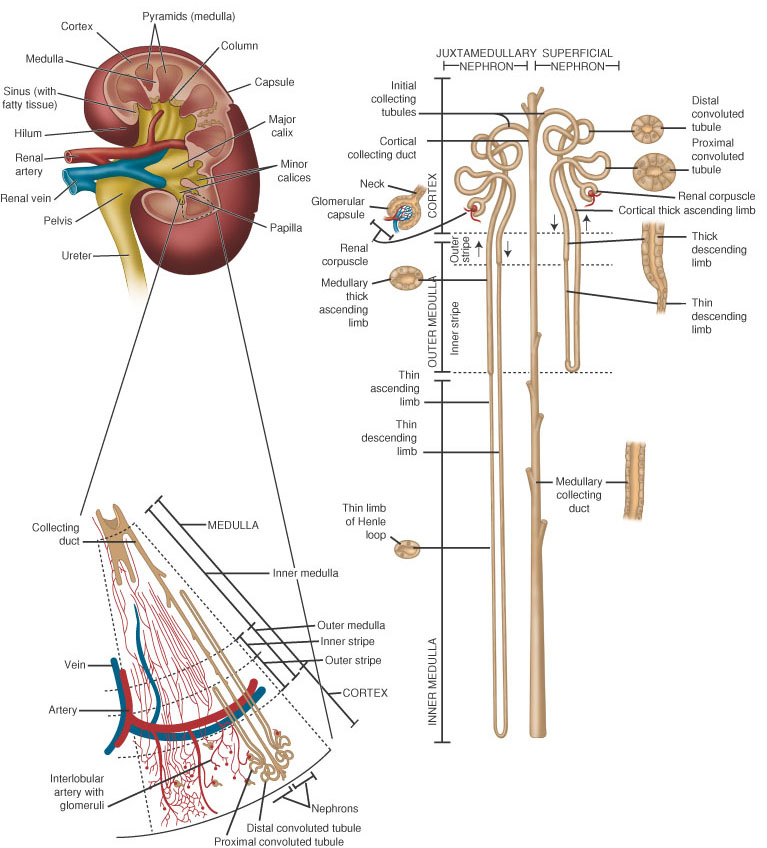
| Kidney either of the two organs in the lumbar region that filter the blood, excreting the end-products of body metabolism in the form of urine, and regulating the concentrations of hydrogen, sodium, potassium, phosphate, and other ions in the extracellular fluid. Called also ren[TA]. Each human kidney is about 11 cm long, 5–7.5 cm wide, and 2.5 cm thick, and weighs from 120 to 160 g. The kidney is of characteristic shape, with a notch known as the hilum on its inner, concave border; renal vessels and nerves and the ureter pass through it, and it communicates with the cavity or sinus of the kidney. The kidney consists of a cortex (see renal cortex, under cortex) and a medulla (see renal medulla, under medulla). The medullary substance forms pyramids, whose bases are in the cortex and whose apices, the renal papillae, project into the calices of the kidney. The renal pyramids number from 10 to 15. The parenchyma of each kidney is composed of about one million renal tubules (nephrons, the functional unit of the kidney), held together by a little connective tissue. Each tubule begins blindly in a renal corpuscle, consisting of a glomerulus and the surrounding glomerular capsule, situated within the cortex. After a neck or constriction below the capsule, it becomes the proximal convoluted tubule, then Henle loop, then the distal convoluted tubule, the connecting tubule, and finally the straight collecting tubule, which opens at the apex of a renal papilla. The straight collecting tubules converge as they descend, forming groups in the center, known as medullary rays. See also Plate 22. |

| abdominal kidney, an
ectopic kidney
found above the iliac crest with its hilum adjacent to the second lumbar
vertebra. amyloid kidney, one with renal amyloidosis. Armanni-Ebstein kidney, a kidney that has Armanni-Ebstein lesions (see under lesion). arteriosclerotic kidney, one having sclerotic changes of intrarenal arteries and large arterioles. artificial kidney, popular term for hemodialyzer. Ask-Upmark kidney, a hypoplastic kidney with fewer lobules than usual and fissures on its surface; most affected persons have severe hypertension, sometimes with hypertensive encephalopathy and retinopathy. The condition may be either congenital or secondary to vesicoureteral reflux with pyelonephritis. Called also segmental renal hypoplasia. atrophic kidney, one reduced in size because of inadequate circulation or loss of nephrons. cake kidney, a fused kidney of bizarre shape with irregular lobes, usually found in the pelvis toward the midline but sometimes found in crossed renal ectopia. cicatricial kidney, one with irregular areas of scarring from reflux nephropathy or pyelonephritis; see renal scarring, under scarring. clump kidney, cake k. congested kidney, one that is edematous and congested, owing to inflammation, impaired venous circulation, or urinary obstruction. Called also large red k. contracted kidney, an atrophic kidney that is scarred and granular. crossed fused ectopic kidney, one with crossed renal ectopia (see under ectopia). crush kidney, the kidney of a person with crush syndrome. cystic kidney, one containing one or more cysts. definite kidney, definitive kidney, metanephros. disk kidney, a disk-shaped fused kidney similar to the doughnut kidney but with more fusion at the two poles. doughnut kidney, a doughnut-shaped fused kidney resulting from bipolar fusion of the renal anlagen before rotation has begun. duplex kidney, one that has two separate collecting systems; there may be a duplex ureter or a single ureter. dysplastic kidney, see renal dysplasia, under dysplasia. ectopic kidney, one not in the usual position (see renal ectopia, under ectopia). The most common types are abdominal, lumbar, pelvic, thoracic, and crossed fused ectopic kidneys. fatty kidney, renal lipomatosis. flea-bitten kidney, a kidney with small, randomly scattered petechiae on its surface, sometimes seen in bacterial endocarditis. floating kidney, nephroptosis. fused kidney, a kidney anomaly, usually with crossed renal ectopia, in which there is a single anomalous organ resulting from partial or complete fusion of the renal anlagen; types include cake kidney, disk kidney, doughnut kidney, horseshoe kidney, and sigmoid kidney. Goldblatt kidney, one in which the blood flow is artificially obstructed by clamping (see Goldblatt clamp, under clamp), resulting in Goldblatt hypertension. head kidney, pronephros. hind kidney, metanephros. horseshoe kidney, a fused kidney consisting of two renal masses in relatively normal positions, linked at one pole (usually the lower one) by a band of tissue that crosses the midline of the body. hypermobile kidney,
nephroptosis. |